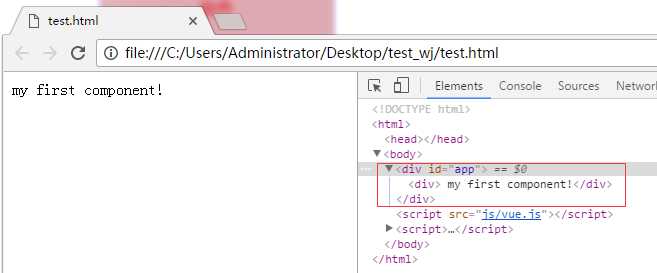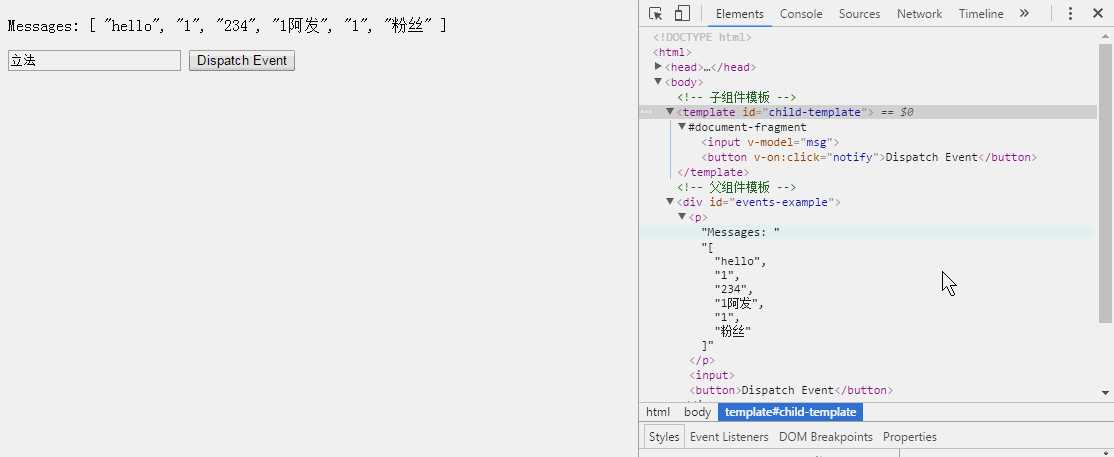Vue.js组件学习
Posted
tags:
篇首语:本文由小常识网(cha138.com)小编为大家整理,主要介绍了Vue.js组件学习相关的知识,希望对你有一定的参考价值。
组件可以扩展html元素,封装可重用的HTML代码,我们可以将组件看作自定义的HTML元素。组件系统提供了一种抽象,让我们可以使用独立可复用的小组件来构建大型应用。
一个简单组件例子(全局注册)
<!DOCTYPE html> <html> <body> <div id="app"> <!-- 3. #app是Vue实例挂载的元素,应该在挂载元素范围内使用组件--> <the-component></the-component> </div> </body> <script src="js/vue.js"></script> <script> // 1.创建一个组件构造器 var myComponent = Vue.extend({ template: ‘<div> my first component!</div>‘ }) // 2.注册组件,并指定组件的标签,组件的HTML标签为<the-component> Vue.component(‘the-component‘, myComponent) new Vue({ el: ‘#app‘ }); </script> </html>
运行结果:

分析:
1.Vue.extent() 是Vue构造器的扩展,调用Vue.extend()创建的是一个组件构造器,而不是一个具体的组件实例。它里面的选项对象的template属性用于定义组件要渲染的HTML。
2.Vue.component() 注册组件时,需要提供2个参数,第一个参数是组件的标签,第二个是组件构造器。它调用了组件构造器myComponent,创建一个组件实例。
3.组件应该挂载在某个Vue实例下,
new Vue({ el: ‘#app‘ });
这段代码必须要有,表示挂载在#app元素上,否则不会生效。
局部注册:
<script>
// 1.创建一个组件构造器
var myComponent = Vue.extend({
template: ‘<div> my first2 component!</div>‘
})
new Vue({
el: ‘#app‘,
components: {
// 2. 将myComponent组件注册到Vue实例下
‘the-component‘ : myComponent
}
});
</script>
父组件和子组件
可以在组件中定义并使用其他组件,构成父子组件关系。
例子:(注意版本用vue.js 1.0的,2.0版本,button都出现不了)
<!DOCTYPE html> <html> <head> <meta charset="utf-8"> </head> <body> <!-- 子组件模板 --> <template id="child-template"> <input v-model="msg"> <button v-on:click="notify">Dispatch Event</button> </template> <!-- 父组件模板 --> <div id="events-example"> <p>Messages: {{ messages | json }}</p> <child></child> </div> </body> <script src="http://cdn.bootcss.com/vue/1.0.0-csp/vue.js"></script> <script> // 注册子组件 // 将当前消息派发出去 Vue.component(‘child‘, { template: ‘#child-template‘, data: function () { return { msg: ‘hello‘ } }, methods: { notify: function () { if (this.msg.trim()) { this.$dispatch(‘child-msg‘, this.msg) this.msg = ‘‘ } } } }) // 初始化父组件 // 将收到消息时将事件推入一个数组 var parent = new Vue({ el: ‘#events-example‘, data: { messages: [] }, // 在创建实例时 `events` 选项简单地调用 `$on` events: { ‘child-msg‘: function (msg) { // 事件回调内的 `this` 自动绑定到注册它的实例上 this.messages.push(msg) } } }) </script> </html>
运行结果:

props示例
<!DOCTYPE html> <html> <head> <meta charset="utf-8"> </head> <body> <template id="myComponent"> <table> <tr> <th colspan="2"> 子组件数据 </th> </tr> <tr> <td>myname</td> <td v-text="myName"></td> </tr> <tr> <td>myage</td> <td v-text="myAge"></td> </tr> </table> </template> <div id="app"> <my-component v-bind:my-name="name" v-bind:my-age="age"></my-component> </div> </body> <script src="http://cdn.bootcss.com/vue/1.0.0-csp/vue.js"></script> <script> var vm = new Vue({ el: ‘#app‘, data: { name: ‘wangjuan‘, age: 24 }, components: { ‘my-component‘: { template: ‘#myComponent‘, props: [‘myName‘, ‘myAge‘] } } }); </script> </html>
结果为:

prop双向绑定
<!DOCTYPE html> <html> <head> <meta charset="utf-8"> </head> <body> <template id="myComponent"> <table> <tr> <th colspan="3"> 子组件数据 </th> </tr> <tr> <td>myname:</td> <td v-text="myName"></td> <td><input type="text" v-model="myName" /></td> </tr> <tr> <td>myage:</td> <td v-text="myAge"></td> <td><input type="text" v-model="myAge" /></td> </tr> </table> </template> <div id="app"> <table> <tr> <th colspan="3">父组件数据</th> </tr> <tr> <td>name:</td> <td>{{ name }}</td> <td><input type="text" v-model="name" /></td> </tr> <tr> <td>age:</td> <td>{{ age }}</td> <td><input type="text" v-model="age" /></td> </tr> </table> <my-component v-bind:my-name="name" v-bind:my-age="age"></my-component> </div> </body> <script src="http://cdn.bootcss.com/vue/2.0.0-rc.8/vue.js"></script> <script> var vm = new Vue({ el: ‘#app‘, data: { name: ‘wangjuan‘, age: 24 }, components: { ‘my-component‘: { template: ‘#myComponent‘, props: [‘myName‘, ‘myAge‘] } } }); </script> </html>
结果:

prop默认是单向绑定,不过这里我感觉默认是双向绑定,不知道哪里出问题了。。。
使用.sync或.once 绑定修饰符显式地强制双向或单次绑定。
子组件可以用this.$parent访问它的父组件。根实例的后代可以用this.$root访问它。父组件有一个数组this.$children,包含它所有的子元素。
以上是关于Vue.js组件学习的主要内容,如果未能解决你的问题,请参考以下文章